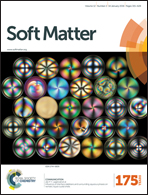Comment on “Curvature capillary migration of microspheres” by N. Sharifi-Mood, I. B. Liu, K. J. Stebe, Soft Matter, 2015, 11, 6768
Abstract
In a recent paper, Sharifi-Mood et al. studied colloidal particles trapped at a liquid interface with opposite principal curvatures c1 = −c2. In the theory part, they claim that the trapping energy vanishes at second order in Δc = c1 − c2, which would invalidate our previous result [Phys. Rev. E: Stat., Nonlinear, Soft Matter Phys., 2006, 74, 041402]. Here we show that this claim arises from an improper treatment of the outer boundary condition on the deformation field. For both pinned and moving contact lines, we find that the outer boundary is irrelevant, which confirms our previous work. More generally, we show that the trapping energy is determined by the deformation close to the particle and does not depend on the far-field.


 Please wait while we load your content...
Please wait while we load your content...